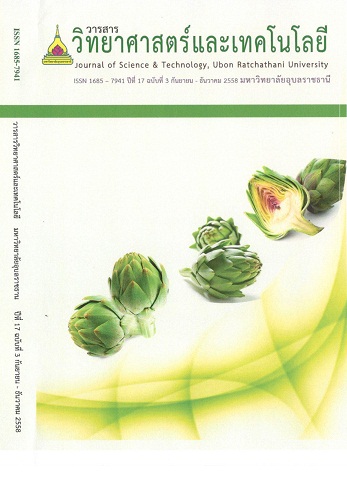Impact of Selected Cultures of Probiotics on Quality of Vanilla Low Fat Ice Cream during Storage
Main Article Content
บทคัดย่อ
Different strains of bacteria can produce different types and ratios of organic acids and volatile compounds, resulting in unique overall sensorial characteristics of fermented food products. The objective of this study was to investigate the effect of probiotic strains on ice cream quality during frozen storage. Three strains of probiotic, Lactobacillus acidophilus BCC51147, Lactobacillus rhamnosus DSM20021, and Lactobacillus casei 01, were incorporated into low fat vanilla ice cream. The samples were kept at -20ºC for 40 weeks. The viability of the probiotics at 0, 20, and 40 weeks was measured by viability count. The pH, acidity, melting property, and consumer acceptance of the ice cream were also determined at 0, 20, and 40 weeks. After 40 weeks of storage, all probiotic strains showed survival rates of 96-98% with viability of more than 7 log cfu/g. Probiotic ice cream had significantly lower pH than the control (no probiotic added) (p< 0.05). Ice cream with added L. acidophilus showed the lowest pH. Acidity of the control and probiotic ice cream with added L. rhamnosus had the lowest acidity (p< 0.05). Probiotic ice cream samples with added L. acidophilus and L. rhamnosus had the highest melting rate (p< 0.05). Consumer acceptance of probiotic ice cream was not significantly different from that of the control in terms of appearance, color, and overall acceptance (p> 0.05). At longer storage times, higher acceptance scores in terms of flavor, taste, and texture were observed for probiotic ice cream (p< 0.05) compared to those of the control. No significant difference in sensory scores for appearance, color, flavor, taste, or overall acceptance were found among probiotic ice cream samples, whereas probiotic ice cream containing L. acidophilus and L. rhamnosus was found to have the highest consumer acceptance in terms of texture.
เชื้อโพรไบโอติกสายพันธุ์ที่แตกต่างกันมีความสามารถในการผลิตสารประกอบอินทรีย์ที่มีความหลากหลายทั้งชนิดและปริมาณ ส่งผลให้ผลิตภัณฑ์อาหารหมักที่ได้มีลักษณะทางประสาทสัมผัสที่เป็นเอกลักษณ์ ในงานวิจัยนี้มีวัตถุประสงค์เพื่อศึกษาผลของเชื้อโพรไบโอติก 3 สายพันธุ์ต่อคุณภาพของไอศกรีมในระหว่าง การเก็บรักษา โดยผลิตไอศกรีมวนิลาไขมันต่าจำนวน 4 ทรีทเมนต์ ได้แก่ ไอศกรีมวนิลาไขมันต่ำผสม Lactobacillus acidophilus BCC51147, ไอศกรีมวนิลาไขมันต่ำผสม Lactobacillus rhamnosus DSM20021, ไอศกรีมวนิลาไขมันต่ำผสม Lactobacillus casei 01 และไอศกรีมวนิลาไขมันต่ำสูตรควบคุม (ไม่เติมเชื้อโพรไบ-โอติก) แล้วเก็บตัวอย่างไว้ที่อุณหภูมิ -20 องศาเซลเซียส เป็นเวลา 40 สัปดาห์ วัดการรอดชีวิตของเชื้อโพรไบโอติกในไอศกรีม พีเอช ปริมาณกรด สมบัติการละลาย และการยอมรับทางประสาทสัมผัสของไอศกรีม ในสัปดาห์ที่ 0, 20 และ 40 หลังการเก็บรักษาเป็นเวลา 40 สัปดาห์พบว่า เชื้อโพรไบโอติกทุกสายพันธุ์มีอัตราการรอดชีวิตอยู่ที่ 96-98% จากปริมาณเชื้อตั้งต้นซึ่งคิดเป็นจำนวนมากกว่า 7 log cfu/g ไอศกรีมที่เติมโพรไบโอติกมีค่าพีเอชต่ำกว่าไอศกรีมสูตรควบคุมอย่างมีนัยสำคัญ (p< 0.05) โดยไอศกรีมที่เติม L. acidophilus มีค่าพีเอชต่ำที่สุด ไอศกรีมสูตรควบคุมและไอศกรีมที่เติม L. rhamnosus มีปริมาณกรดต่ากว่าสูตรอื่นอย่างมีนัยสำคัญ (p< 0.05) ไอศกรีมที่เติม L. acidophilus และไอศกรีมที่เติม L. rhamnosus มีอัตราการละลายสูงที่สุดอย่างมีนัยสำคัญ (p< 0.05) การทดสอบทางประสาทสัมผัสพบว่าไม่มีความแตกต่างกันอย่างมีนัยสำคัญ (p>0.05) ระหว่างไอศกรีมที่เติมโพรไบ-โอติกและไอศกรีมสูตรควบคุมในด้านลักษณะปรากฏ สี และความชอบโดยรวม และเมื่อเก็บไอศกรีมที่เติม โพรไบโอติกไว้เป็นระยะเวลานานขึ้นพบว่า การยอมรับทางด้านกลิ่นรส รสชาติ และเนื้อสัมผัส มีค่าสูงกว่าไอศกรีมสูตรควบคุม ผู้บริโภคไม่พบความแตกต่างทางด้านลักษณะปรากฏ สี กลิ่นรส รสชาติ และความชอบโดยรวมของไอศกรีมที่เติมโพรไบโอติก ในขณะที่ไอศกรีมที่เติม L. acidophilus และ ไอศกรีมที่เติม L. rhamnosus มีคะแนนการยอมรับในด้านเนื้อสัมผัสสูงที่สุด
Article Details
บทความที่ได้รับการตีพิมพ์เป็นลิขสิทธิ์ของ วารสารวิทยาศาสตร์และเทคโนโลยี มหาวิทยาลัยอุบลราชธานี
ข้อความที่ปรากฏในบทความแต่ละเรื่องในวารสารวิชาการเล่มนี้เป็นความคิดเห็นส่วนตัวของผู้เขียนแต่ละท่านไม่เกี่ยวข้องกับมหาวิทยาลัยอุบลราชธานี และคณาจารย์ท่านอื่นๆในมหาวิทยาลัยฯ แต่อย่างใด ความรับผิดชอบองค์ประกอบทั้งหมดของบทความแต่ละเรื่องเป็นของผู้เขียนแต่ละท่าน หากมีความผิดพลาดใดๆ ผู้เขียนแต่ละท่านจะรับผิดชอบบทความของตนเองแต่ผู้เดียว


